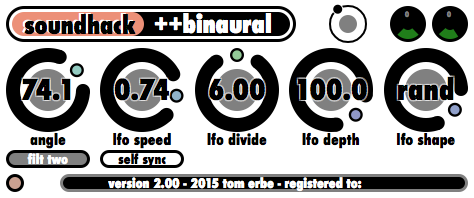++binaural is a filter which places a sound at a specific position around the listener’s head. It does this by using filters which simulate the filtering effect of the head and outer ear for sounds at all angles. The filters in ++binaural are optimized for headphones and are only for 0 degree elevation at a 44100 sample rate. Future versions of ++binaural will contain multiple elevations and sample rates.

Controls
angle – This is where you set the position of the sound. The angle can be varied from –180 degrees to 180 degrees. 0 degrees is straight ahead, 90 is to the right, –90 is to the left, 180 and –180 are both directly behind the listener. The current position is visualized by the orbit graphic on the upper right of the plugin
lfo speed – This sets the speed of the LFO from –1 Hz to 1 Hz. A negative speed causes a reverse rotation through the LFO envelope. If lfo sync is on, the lfo speed is set by the MIDI clock.
lfo divide – This control slows down the lfo speed by dividing it by numbers from 1 to 11. This gives you an extremely slow LFO if desired.
lfo depth – This control increases and decreases the effect of the LFO. With this you can have the filter “wobble” around a given angle.
lfo shape – LFO shapes of ramp, sine, square and random can be selected, which affect the speed of trajectory.
filt one/filt two – These buttons allow you to select between two binaural filter sets. filter one is derived from Bill Gardner and Keith Martin’s measurements of the KEMAR dummy head microphone at the MIT Media Lab (http://sound.media.mit.edu/KEMAR.html). The diffuse–field equalized HRTFs are used in this plugin. filter two is the original SoundHack binaural filter developed by Dr. Durand Begault.
lfo sync – This button will synchronize the LFO to the host application’s MIDI clock (if there is one). If there is no MIDI clock, this button won’t do anything.
Suggested Uses for ++binaural
++binaural will most often be used when a more accurate pan control with front and rear depth is needed. It can be used along with a reverb (to simulate distance) to recreate a sound stage or other virtual environment. When used with lfo sync, ++binaural can be used to place various beats or parts of a loop in specific repeatable positions.